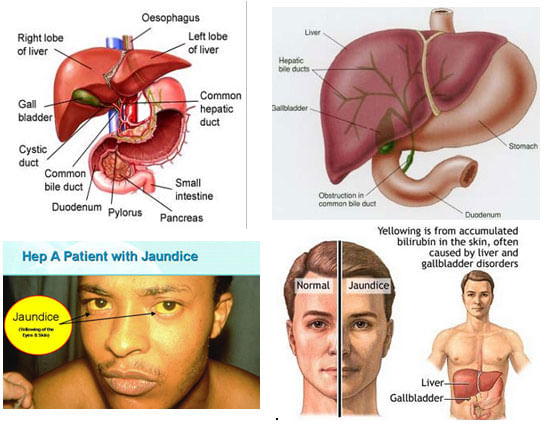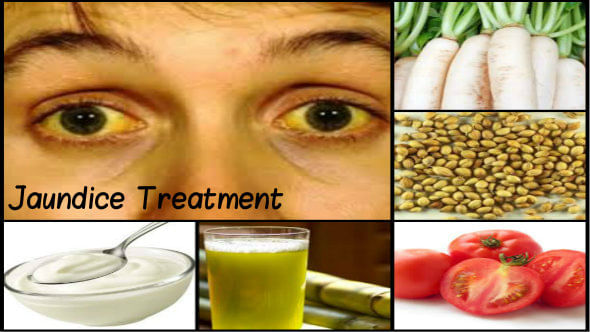Understanding Jaundice (Kamala)
Jaundice (also known as icterus) is a yellowish pigmentation of the skin, the conjunctival membranes over the sclera (whites of the eyes), and other mucous membranes caused by hyperbilirubinemia (increased levels of bilirubin in the blood).
This hyperbilirubinemia subsequently causes increased levels of bilirubin in the extracellular fluid. The concentration of bilirubin in blood plasma does not normally exceed 1 mg/dl (gt 17 x00b5 mol/l). A concentration higher than 1.8 mg/dl (gt 30 x00b5 mol/l) leads to jaundice. This is a brief presentation on jaundice and its ayurvedic management.
Jaundice, also known as icterus is a disease caused due to the dysfunction of the liver. It is the most common of all liver disorders that result from an obstruction in the bile duct or the loss of the bile producing liver cells.
Jaundice refers to the yellowing of skin and whites of the eyes caused by the high level of the pigment bilirubin in the body. Bile is a vital digestive fluid that is essential for proper nutrition. It is unable to function properly and filtering and elimination of toxins from your system is affected.
Jaundice is caused mainly by the dysfunctional liver or other liver diseases. In tropical countries, jaundice is more likely to happen because of the extreme nature of summer heat and digestive difficulties that it causes. Chronic digestive disorders like bowels inflammatory syndromes, gastric problems also play bigger roles in causing the disease.
In relation to these internal causes, jaundice can be of various types. Apart from this hepatitis virus can cause some major types of jaundice which can be potentially life threats. Obstructive jaundice is another type of jaundice which is caused by obstruction caused in the liver function to relieve the bilirubin from the body.
Pregnancy related jaundice and jaundice at childbirth are other types of jaundice which are more common in pregnant women. Before introducing some of the major types of jaundice, for a better clinical understanding of the disease let us take a look at the basic process which causes jaundice.
Causes, incidence, and risk factors:
Every day, a small number of red blood cells in your body die and are replaced by new ones. The liver removes the old blood cells, forming bilirubin. The liver helps break down bilirubin so that it can be removed by the body in the stool.
This waste product is called bilirubin and when liver cannot perform its assigned function of relieving this waste product from our organic process the higher amount of presence of this chemical substance in the blood is felt and this is how jaundice occurs.
All major types of jaundice can have different areas of reasoning for the malfunction of the production process and relieving process of bilirubin, but the basic facts related with the bilirubin and its effects are all same in all minor or major types of jaundice
When too much bilirubin builds up in the body, jaundice may result.
Jaundice is caused due to the following causes:
- Obstruction of the bile ducts (by infection, tumor or gallstones)
- Viral hepatitis (hepatitis a, hepatitis b, hepatitis c, hepatitis d, and hepatitis e)
- Drug-induced cholestasis (bile pools in the gallbladder because of the effects of drugs)
- Drug-induced hepatitis (hepatitis triggered by medications, including erythromycin sulfa drugs, antidepressants, anti-cancer drugs, Aldomet, rifampin, steroids, chlorpropamide, tolbutamide, oral contraceptives, testosterone, propylthiouracil)
- Biliary structure
- Alcoholic liver disease (alcoholic cirrhosis)
- Pancreatic carcinoma (cancer of the pancreas)
- Primary biliary cirrhosis
- Ischemic hepatocellular jaundice (jaundice caused by inadequate oxygen or inadequate blood flow to the liver)
- Intrahepatic cholestasis of pregnancy (bile pools in the gallbladder because of the pressure in the abdomen with pregnancy)
- Haemolytic anemia
- Congenital disorders of bilirubin metabolism (gilbert&s syndrome, dubin-johnson syndrome, rotor&s syndrome)
- Chronic active hepatitis
- Autoimmune hepatitis
- Malaria
Jaundice is often a sign of a problem with the liver, gallbladder, or pancreas. Infections, use of certain drugs, cancer, blood disorders, gallstones, birth defects and a number of other medical conditions can lead to jaundice.
Clinical symptoms:
Jaundice may appear suddenly or develop slowly over time. Common symptoms of jaundice commonly include:
- Yellow skin and the white part of the eyes (sclera) -- when jaundice is more severe, these areas may look brown
- Yellow color inside the mouth
- Dark or brown-colored urine
- Pale or clay-colored stools
Other symptoms depend on the disorder causing jaundice:
Cancers may produce no symptoms, or there may be fatigue, weight loss, or other symptoms
Hepatitis may produce nausea, vomiting, fatigue, or other symptoms.
Differential diagnosis:
When a pathological process interferes with the normal functioning of the metabolism and excretion of bilirubin just described, jaundice may be the result. Jaundice is classified into three categories, depending on which part of the physiological mechanism the pathology affects.
- Pre-hepatic jaundice: it is caused by anything which causes an increased rate of hemolysis (breakdown of red blood cells).
Laboratory findings include:
- Urine: no bilirubin present, urobilinogen gt; 2 units (i.e. hemolytic anemia causes increased heme metabolism; exception: infants where gut flora has not developed).
- Serum: increased unconjugated bilirubin. Kernicterus is associated with increased unconjugated bilirubin.
- Hepatocellular jaundice: It can be caused by acute or chronic hepatitis, hepatotoxicity, cirrhosis, drug induced hepatitis and alcoholic liver disease.
Laboratory findings include:
- Urine: conjugated bilirubin present, urobilirubin gt; 2 units but variable (except in children). Kernicterus is a condition not associated with increased conjugated bilirubin.
- Plasma protein show characteristic changes.
- Plasma albumin level is low but plasma globulins are raised due to an increased formation of antibodies.
- Post-hepatic jaundice: it is also called obstructive jaundice, is caused by an interruption to the drainage of bile in the biliary system. The most common causes are gallstones in the common bile duct, and pancreatic cancer in the head of the pancreas. Also, a group of parasites known as' liver flukes' can live in the common bile duct, causing obstructive jaundice.
The presence of pale stools and dark urine suggests an obstructive or post-hepatic cause as normal feces get their color from bile pigments. However, although pale stools and dark urine is a feature of biliary obstruction, they can occur in many intra-hepatic illnesses and are therefore not a reliable clinical feature to distinguish obstruction from hepatic causes of jaundice. Patients also can present with elevated serum cholesterol, and often complain of severe itching or' pruritus' because of the deposition of bile salts.
Signs and tests:
No single test can differentiate between various classifications of jaundice. A combination of liver function tests is essential to arrive at a diagnosis.
Other tests vary, but may include:
- Hepatitis virus panel to look for infection of the liver
- Liver function tests to determine how well the liver is working
- Complete blood count to check for low blood count or anemia
- Abdominal ultrasound
- Abdominal ct scan
- Endoscopic retrograde cholangiopancreatography (ercp)
- Percutaneous transhepatic cholangiogram (ptca)
- Liver biopsy
- Cholesterol level
- Prothrombin time
Ayurvedic approach:
In the ayurvedic perspectrive jaundice (kamala) is a complaint of the pitta region of the body, which denotes a build up of toxins in an intestinal area that is causing an in-balance in the overall dosha. You need to expel such toxins to rebalance the immune system and yourself.
All the great indian laureates viz. Acharaya charaka, sushruta and vagbhatta have described the yakrita roga (liver diseases). Acharaya charaka has mentioned a detailed description of kamala roga in connection with liver disease. He has given details of nidan, samprapti, rupa, bheda, sadhyasadhayata and chikitsa karma. The concept of kamala in ayurveda kayam malyati iti kamala. i.e. The whole body becomes dirty because of accumulation of pitta in the body which refers to accumulation of bilirubin in this context.
Kamala produces various signs and symptoms as haridra netra (yellow discoloration of conjunctiva), haridra twaka (yellow colour of skin), haridra nakha (yellow nails), bheka varna (frog like body color), daha (burning sensation), ajirna (indigestion), daurbalaya (weakness), kshudhanasha (anorexia) etc.
Management:
Since liver is the largest organ and main site of metabolism and detoxification, the diet should be easily digestible during this condition. So ayurvedic treatment contains such medicines which will facilitate removal of waste substances from the gut and kidney.
The treatment of kamala (jaundice) must start with purgation. The basic theory is that no burden be placed on the liver and for that, a daily purgative is recommended. A diuretic may also be administered to encourage the flow of urine, which will expel most of the bile from the system this helps to remove the toxins accumulated in the liver and the rest of the body. Strong purgatives are avoided. Oral medicines and rasayana treatments are also given to the patient. Strong purgatives are avoided.
Ayurvedic treatments for jaundice will aim to rectify the pitta imbalance and eliminate the toxins accumulated in the human system. Elimination of toxins is done through the panchakarma treatments that begin with an oil massage followed by mild emesis and purgation with bitter herbs.
Medicines used:
- Regular intake of avipattikar churna about one- teaspoonful twice a day with hot water.
- Arogyavardhani vati 2-2 tablets regularly with hot water twice a day.
- Punarnava mandoor, 1 tab thice daily for 2 to 3 weeks.
- Navrayas loh can also be given in the dose of 125mg thrice daily.
- Daily consumption of triphala powder (10gm) soaked in water overnight. (equivalent to lactulose)
- Regular intake of guduchi juice 10gm twice or thrice a day.
- Daily intake of neem juice is also useful for jaundice
- Rohitakyadi, punarnava, phalatrikyadi kwath, dhatri lauha etc. May also be used.
Some routine home remedies:
- Mix 1 teaspoon of roasted barley powder to 1 cup of water. Add 1 teaspoon of honey to it and have this twice a day.
- Add 1 teaspoon paste of basil leaves to a cup of radish juice. Have this juice twice a day for 15-20 days.
- Have a cup of sugarcane juice with teaspoon of basil leaves paste twice a day.
- Juice should be prepared in hygienic conditions so as to avoid contamination from dust or other substances
Pathya-apathya (Do's & Don'ts):
Avoid non-vegetarian foods at least till the effects of the jaundice last on the skin. Do not take even heavy vegetarian foods. The reason is that the liver needs to produce more bile to digest these heavy foodstuffs and this could alleviate the pigmentation of the skin.
Completely restrict your intake of junk food such as chocolate, cakes, pastries, potato chips, ice-creams, colas and other aerated drinks, etc.
Always drink water that is filtered or boiled. Do not drink raw milk.
Do not eat sea foods especially oysters, unless you are sure they have come from a reliable source.
Take simple food for the first three days of the jaundice affliction. Have a meal of porridge, especially rice gruel (kanji). You can flavor it with jaggery syrup or honey.
There must be a complete abstinence of salt as it is a mineral and requires a difficult digestion process.
Do not give cereals and pulses to the patient as they cause inflammation in the liver. Grapes, black soya beans, nuts, sweet potatoes are the fruits that are beneficial in jaundice.
Vegetable salad of tomato, carrot, radish and its leaves, and two-three slices of lemon are very good for health and very effective in curing jaundice in a natural way.
It is advised for the patient suffering with jaundice to take proper rest and drink fruit juices.
Bitter vegetables like bitter gourd and the bitter variety of drumsticks are beneficial to the jaundice patient.
Alcohol is very harmful to the jaundice patient. It can complicate the disease with fatal consequences. Hence say a strict no to alcohol.




+1.svg)
